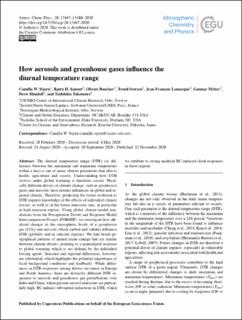| dc.contributor.author | Stjern, Camilla Weum | |
| dc.contributor.author | Samset, Bjørn Hallvard | |
| dc.contributor.author | Boucher, Olivier | |
| dc.contributor.author | Iversen, Trond | |
| dc.contributor.author | Lamarque, Jean-Francois | |
| dc.contributor.author | Myhre, Gunnar | |
| dc.contributor.author | Shindell, Drew | |
| dc.contributor.author | Takemura, Toshihiko | |
| dc.date.accessioned | 2021-08-25T10:40:52Z | |
| dc.date.available | 2021-08-25T10:40:52Z | |
| dc.date.created | 2020-12-01T17:46:03Z | |
| dc.date.issued | 2020 | |
| dc.identifier.citation | Atmospheric Chemistry and Physics. 2020, 20 (21), 13467-13480. | en_US |
| dc.identifier.issn | 1680-7316 | |
| dc.identifier.uri | https://hdl.handle.net/11250/2771142 | |
| dc.description.abstract | The diurnal temperature range (DTR) (or difference between the maximum and minimum temperature within a day) is one of many climate parameters that affects health, agriculture and society. Understanding how DTR evolves under global warming is therefore crucial. Physically different drivers of climate change, such as greenhouse gases and aerosols, have distinct influences on global and regional climate. Therefore, predicting the future evolution of DTR requires knowledge of the effects of individual climate forcers, as well as of the future emissions mix, in particular in high-emission regions. Using global climate model simulations from the Precipitation Driver and Response Model Intercomparison Project (PDRMIP), we investigate how idealized changes in the atmospheric levels of a greenhouse gas (CO2) and aerosols (black carbon and sulfate) influence DTR (globally and in selected regions). We find broad geographical patterns of annual mean change that are similar between climate drivers, pointing to a generalized response to global warming which is not defined by the individual forcing agents. Seasonal and regional differences, however, are substantial, which highlights the potential importance of local background conditions and feedbacks. While differences in DTR responses among drivers are minor in Europe and North America, there are distinctly different DTR responses to aerosols and greenhouse gas perturbations over India and China, where present aerosol emissions are particularly high. BC induces substantial reductions in DTR, which we attribute to strong modeled BC-induced cloud responses in these regions. | en_US |
| dc.language.iso | eng | en_US |
| dc.publisher | Copernicus publications | en_US |
| dc.rights | Navngivelse 4.0 Internasjonal | * |
| dc.rights.uri | http://creativecommons.org/licenses/by/4.0/deed.no | * |
| dc.title | How aerosols and greenhouse gases influence the diurnal temperature range | en_US |
| dc.type | Journal article | en_US |
| dc.type | Peer reviewed | en_US |
| dc.description.version | publishedVersion | en_US |
| dc.source.pagenumber | 13467-13480 | en_US |
| dc.source.volume | 20 | en_US |
| dc.source.journal | Atmospheric Chemistry and Physics | en_US |
| dc.source.issue | 21 | en_US |
| dc.identifier.doi | 10.5194/acp-20-13467-2020 | |
| dc.identifier.cristin | 1855009 | |
| dc.relation.project | Norges forskningsråd: 244141 | en_US |
| dc.relation.project | Norges forskningsråd: 229778 | en_US |
| dc.relation.project | Internasjonale organisasjoner: JSPS KAKENHI (grant no. JP19H05669) | en_US |
| dc.relation.project | Meteorologisk institutt: 181090 | en_US |
| cristin.ispublished | true | |
| cristin.fulltext | original | |
| cristin.qualitycode | 2 | |

